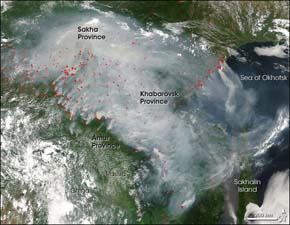This image, captured by NASA’s Terra and Aqua satellites on June 30, shows a pall of smoke drifting over a vast area of Siberia and wafting across Sakhalin Island and into the Sea of Okhotsk and the Pacific Ocean. Hundreds of fires, which have destroyed at least 37,000 acres, burned as overtaxed fire crews were unable to extinguish the blazes. Russian scientists say that rising temperatures in Siberia — much of the region has experienced temperature increases of 2 degrees C over the past half-century — are making its boreal and temperate forests more susceptible to fire. Increased logging, much of it driven by China, also plays a role as the cutting brings more people into once-inaccessible sections of the taiga.
Smoke Blankets Eastern Siberia As Higher Temperatures Spawn Forest Fires
More From E360
-
SPACE
Scientists Warn of Emissions Risks from the Surge in Satellites
-
WILDLIFE
A Troubling Rise in the Grisly Trade of a Spectacular African Bird
-
MINING
In Myanmar, Illicit Rare Earth Mining Is Taking a Heavy Toll
-
INTERVIEW
How Batteries, Not Natural Gas, Can Power the Data Center Boom
-
ANALYSIS
As U.S. and E.U. Retreat on Climate, China Takes the Leadership Role
-
Solutions
From Ruins to Reuse: How Ukrainians Are Repurposing War Waste
-
ANALYSIS
Carbon Offsets Are Failing. Can a New Plan Save the Rainforests?
-
Energy
Facing a Hostile Administration, U.S. Offshore Wind Is in Retreat
-
Biodiversity
As Jaguars Recover, Will the Border Wall Block Their U.S. Return?
-
WATER
An E.U. Plan to Slash Micropollutants in Wastewater Is Under Attack
-
INTERVIEW
This Data Scientist Sees Progress in the Climate Change Fight
-
Climate
As Floods Worsen, Pakistan Is the Epicenter of Climate Change
